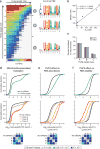Protein-RNA networks revealed through covalent RNA marks
- PMID: 26524240
- PMCID: PMC4707952
- DOI: 10.1038/nmeth.3651
Protein-RNA networks revealed through covalent RNA marks
Abstract
Protein-RNA networks are ubiquitous and central in biological control. We present an approach termed RNA Tagging that enables the user to identify protein-RNA interactions in vivo by analyzing purified cellular RNA, without protein purification or cross-linking. An RNA-binding protein of interest is fused to an enzyme that adds uridines to the end of RNA. RNA targets bound by the chimeric protein in vivo are covalently marked with uridines and subsequently identified from extracted RNA via high-throughput sequencing. We used this approach to identify hundreds of RNAs bound by a Saccharomyces cerevisiae PUF protein, Puf3p. The results showed that although RNA-binding proteins productively bind specific RNAs to control their function, they also 'sample' RNAs without exerting a regulatory effect. We used the method to uncover hundreds of new and likely regulated targets for a protein without canonical RNA-binding domains, Bfr1p. RNA Tagging is well suited to detect and analyze protein-RNA networks in vivo.
Conflict of interest statement
The authors declare competing financial interests. C.P.L. and M.W. have filed a patent that encompasses the RNA Tagging approach.
Figures





Comment in
-
Techniques: Exploring protein-RNA interactions with RNA Tagging.Nat Rev Genet. 2016 Jan;17(1):6. doi: 10.1038/nrg.2015.6. Epub 2015 Nov 16. Nat Rev Genet. 2016. PMID: 26567777 No abstract available.
References
Publication types
MeSH terms
Substances
Grants and funding
LinkOut - more resources
Full Text Sources
Other Literature Sources
Molecular Biology Databases
Research Materials

